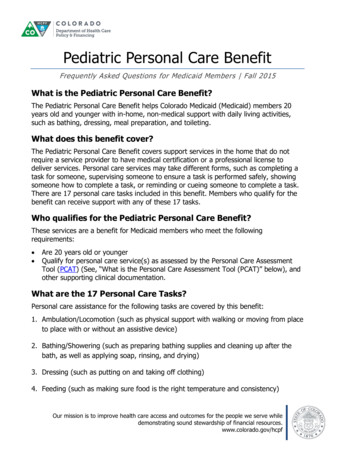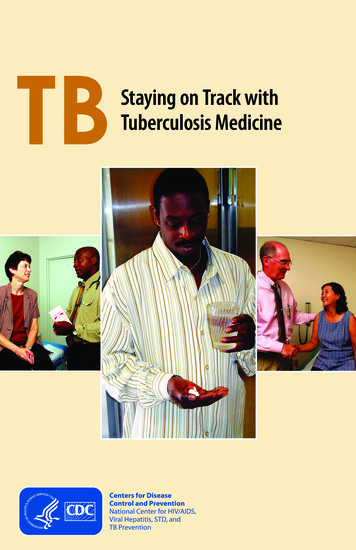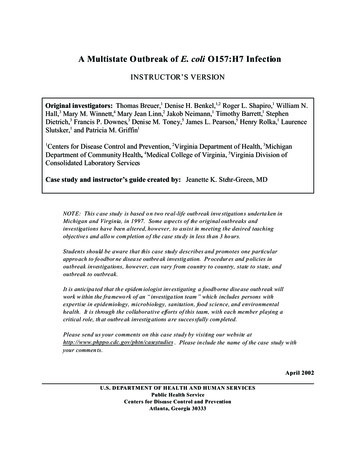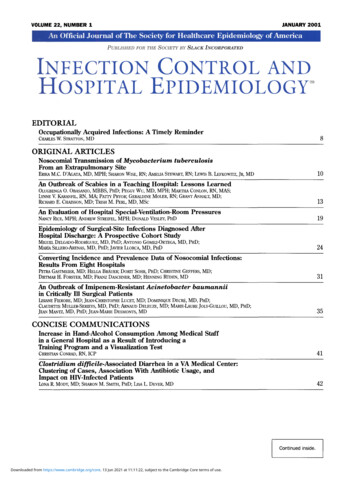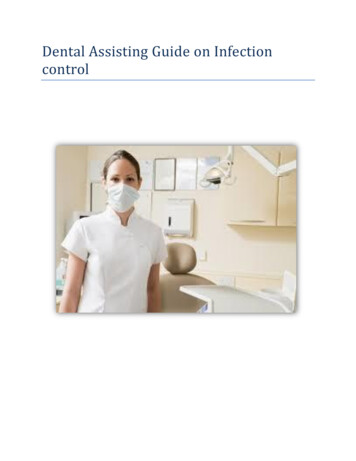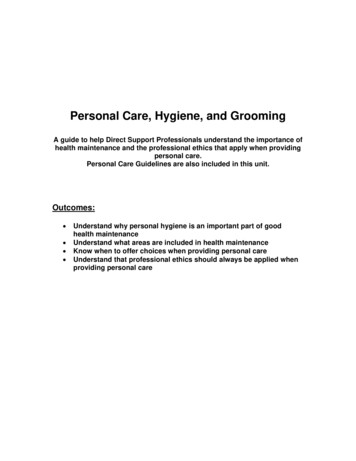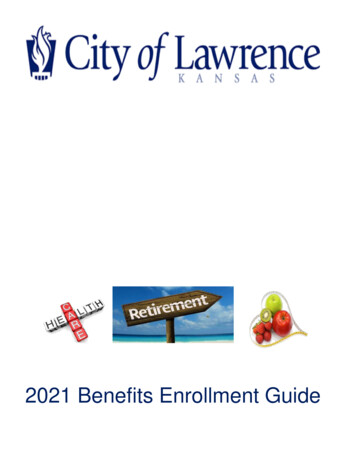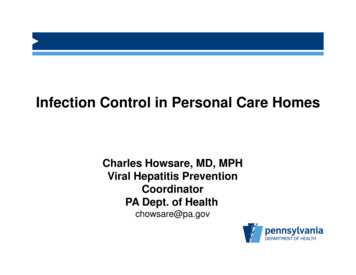
Transcription
Infection Control in Personal Care HomesCharles Howsare, MD, MPHViral Hepatitis PreventionCoordinatorPA Dept. of Healthchowsare@pa.gov
No Conflicts of Interest2
Getting to Know Each Other Who am I? Who are you? Why are we here?33
Objectives --- Make an Impact Necessary but not sufficient Offer a safe living environment for people invulnerable situations Offer a safe working environment for workers Adopt sustainable policies Risk management just makes good business sense44
Worse for those persons in the dawn,twilight and shadows of lifeIt was once said that the moral test of Government is howthat Government treats those who are in the dawn of life,the children; those who are in the twilight of life, the elderly;and those who are in the shadows of life, the sick, theneedy and the handicapped.— Hubert H. Humphrey55
Vulnerable Residents & Employees Group setting– Close proximity– Eating in same facility– Poor hygiene?– Frequently touched surfaces Aging, poor health, mental and physical disabilities Germ swapping (in/out of hospital, guests) Rely on you!66
Infectious Diseases Direct contact– Blood and body fluids, contaminated hands Indirect contact– Needle sticks, glucometer sharing, contaminated surfaces Airborne transmission– Sneezing Vector-borne transmission– Fleas, ticks, mosquitos, flies, lice, etc Foodborne transmission– Contaminated food, spoiled food77
Person, Place & Bug88
Chain of Transmission99
Breaking Chain of Transmission1010
Routes of Transmission Respiratory/inhalation Skin/dermal– Rash or broken skin Oral Mucous Membrane1111
Transmission Examples Spray and Droplet Dermal12
What is an Outbreak? More than expected– Cluster of similar symptoms– Person, place and time Certain group of residents? One floor? Sometimes a single case to start– Influenza in a group/institutional setting Often asymptomatic or symptoms delayed1313
Houston, we have a problem. Index of suspicion– If it sounds like a pig, and smells like a pig .likely a pig– Risk and probability Listen to your employees and listen to yourresidents .really listen High risk circumstances– In house blood testing– Sick residents– Residents returning from the hospital Reporting an outbreak1414
What is Infection Control? OSHA is not infection control and infection control isnot OSHA Infection Control is a dynamic, active process of:– Policy Formulation and Implementation– Education and Training– Surveillance– Monitoring and Audit1515
Hierarchy of Safety and Health Controls Training and administrative controls– IC plan, training, job sheets, quality assurance– Right med, right patient, right time, right dose Engineering controls– Med room setup– Where are your sinks, sharps containers, hazardouswaste1616
Hierarchy of Safety and Health Controls Work practice controls– Hand hygiene practices– Food handling practices– Environmental cleaning Personal protective equipment– Gloves– Gowns– Masks Examples1717
Environmental Cleaning Decontamination Low-level disinfectant EPA-registered Contact time1818
What is Hand Hygiene? Handwashing– Washing hands with plain soap and water– Washing hands with water and soap or otherdetergents containing an antiseptic agent Alcohol-based handrub– Rubbing hands with an alcohol-containing preparation1919
Why don’t people wash hands? Handwashing agents cause irritation and dryness Sinks are inconveniently located/lack of sinks Lack of soap and paper towels Too busy/insufficient time Understaffing/overcrowding Patient needs take priority Low risk of acquiring infection from patientsAdapted from Pittet D, Infect Control Hosp Epidemiol 2000;21:381-386.20
When should I do hand hygiene? When hands are visibly dirty, contaminated, orsoiled, wash with non-antimicrobial or antimicrobialsoap and water. If hands are not visibly soiled, use an alcohol-basedhandrub for routinely decontaminating hands.2121
Selection of Hand Hygiene Agents:Factors to Consider Efficacy of antiseptic agent Acceptance of product by healthcare personnel Characteristics of product Skin irritation and dryness Accessibility of product Dispenser systems (example trade offs)Guideline for Hand Hygiene in Health-care Settings. MMWR 2002; vol. 51, no. RR-16.2222
5 Moments of Hand Hygiene2323
Alcohol Hand Rubs are Faster Hand washing with soap and water: 56 minutes Based on seven (60 second) handwashing episodesper hour Alcohol-based handrub: 18 minutes Based on seven (20 second) handrub episodes perhour24Voss A and Widmer AF, Infect Control Hosp Epidemiol 1997:18;205-208.24
Summary: Alcohol-Based Handrubs Require less time More effective for standard hand washing than soap More accessible than sinks Reduce bacterial counts on hands Improve skin condition2525
Efficacy of Hand Hygiene Preparations inKilling BacteriaGoodBetterPlain SoapAntimicrobialsoapBestAlcohol-basedhandrub2626
Personal Protective Equipment “specialized clothing or equipment worn by anemployee for protection against infectiousmaterials” (OSHA) Break the chain of transmission– To employees– To other residents– Ever seen a food handler that never changes gloves? What type of personal protective equipment do youhave in your facilities?2727
Gloves --- not all the same Purpose – patient care, environmental services,other Glove material – vinyl, latex, nitrile, other Sterile or non-sterile One or two pair Single use or reusable2828
Role of Gloves and Hand Hygiene If it’s wet and not yours, don’ttouch it.2929
Glove Use Requires Training & Assessment Work from “clean to dirty” Limit opportunities for “touch contamination” protect yourself, others, and the environment Don’t touch your face or adjust PPE withcontaminated gloves Don’t touch environmental surfaces except asnecessary during patient care Change gloves3030
Glove Use Requires Training & Assessment During use if torn and when heavily soiled (evenduring use on the same patient) After use on each patient Discard in appropriate receptacle Never wash or reuse disposable gloves3131
What is Infection Control? Infection Control is a dynamic, active process of:– Policy Formulation and Implementation– Education and Training– Surveillance– Monitoring and Audit Infection Control quality assurance is crucial– Just because you have a program .doesn’t mean it works toreduce risk and avoid transmission.3232
BREAK3333
What is Infection Control? Infection Control is a dynamic, active process of:– Policy Formulation and Implementation– Education and Training– Surveillance– Monitoring and Audit Infection Control quality assurance is crucial– Just because you have a program .doesn’t mean it works toreduce risk and avoid transmission.3434
Mississippi Nursing HomeOutbreak recognized after two fatal cases of acute HBVinfection among residents of nursing home A Among 38 residents who routinely received finger sticksfor glucose monitoring, 14 had acute HBV infection,compared with one of 106 residents who did not receivefinger sticks Nursing home A was:– equipped with one glucometer and one spring-loaded, pen-likefinger stick device.– the spring-loaded barrel and glucometer were not routinelycleaned between patients– several staff members reported observing other workers reuse aneedle or lancet or fail to change gloves between patients.3535
Los Angles Assisted Living CenterFour residents with diabetes in assisted living center Bdeveloped acute HBV infection during November 2003-January 2004-Of 22 diabetic residents tested (three declined), eight(36%) had acute HBV infection-Of the nine patients who had daily exposure to finger stickprocedures performed by nursing staff, eight had acuteHBV infection, compared with none among the sevenresidents who performed their own finger sticks-Although receipt of insulin was also significantlyassociated with infection, two residents with acute HBVinfection had not received insulin.3636
North Carolina Nursing HomeAn acute case of HBV infection in a resident of nursinghome C was reported to the North Carolina Departmentof Health June--July 2003-Serologic testing was performed on 192 residents; 11 (6%)had acute HBV infection-Of 45 residents who received finger sticks for glucosemonitoring, eight (18%) had acute HBV infection, comparedwith three (3%) of 117 residents without this exposure3737
North Carolina Nursing HomeAn acute case of HBV infection in a resident of nursinghome C was reported to the North Carolina Departmentof Health June--July 2003-Interviews with staff and direct observation: Only single-use lancets were used A single glucometer was used for all patients receiving finger sticks Glucometers were not routinely cleaned between patients. On some days, a single health-care worker performed approximately20 finger stick procedures during a single work shift. Anonymous survey: some health-care workers did not alwayschange gloves between patients when performing finger stickprocedures.3838
Infection Prevention during BloodGlucose Monitoring and InsulinAdministration Reusable Devices: CDC recommends that devicesnever be used for more than one person.A simple rule for safe care:1)Finger stick devices, 2)glucometers,and 3)needles (insulin or otherwise)should never be used for more than oneperson.3939
Blood Glucose Monitoring Finger stick Devices– Restrict use of finger stick devices to individual persons. Theyshould never be used for more than one person.– Dispose of used lancets at the point of use in an approvedsharps container Blood glucose meters should be assigned to anindividual person and not be shared. Unused supplies and medications should bemaintained in clean areas separate from usedsupplies and equipment (e.g., glucose meters).4040
Insulin Administration Insulin pens should be assigned to individual personsand labeled appropriately. They should never be usedfor more than one person. Multiple-dose vials of insulin should be dedicated to asingle person whenever possible.– Medication vials should always be entered with a new needleand new syringe– Dispose of used injection equipment at point of use in anapproved sharps container. Never reuse needles or syringes. Wear gloves, change gloves between patient contacts,and perform hand hygiene immediately after removal ofgloves4141
Training and Oversight Review regularly, individual schedules for persons requiring assistance, withblood glucose monitoring and/or insulin administration. Provide a full hepatitis B vaccination series to all previously unvaccinatedstaff persons whose activities involve contact with blood or body fluids. Establish responsibility for oversight of infection control activities. Providestaff members who assume responsibilities for finger sticks and injectionswith infection control training. Assess adherence to infection control recommendations for blood glucosemonitoring and insulin administration by periodically observing staff whoperform or assist with these procedures and tracking use of supplies. Report to public health authorities any suspected instances of a newlyacquired blood borne infection, such as hepatitis B, in a patient, facilityresident, or staff member.4242
Bloodborne Pathogens HIV– Not common in assisted living environments HEPATITIS B– Worst culprit in assisted living environments– Very infective (100x more than HIV), easily transmitted– Most residents are not immunized, many care workers aren’timmunized HEPATITIS C– Common in older people– 10x more infective than HIV, but not as infectious as HBV– No immunization4343
Hepatitis B (HBV) Viral infection, attacks liver, can cause acute and chronicdisease 1.2 million in US with chronic HBV, many don’t know they areinfected Transmitted through contact with blood or other body fluids ofinfection persons 50-100 times more infections than HIV (semen, vaginal fluids,blood) NOT breastmilk or saliva Important occupational hazard Safe and effective vaccine4444
Hepatitis C (HCV) Liver disease caused by the hepatitis C virus 3.2 million people in the US with chronic HCV, less than45% know their positive status Range in severity from a mild illness lasting a fewweeks to a serious, lifelong condition that can lead tocirrhosis of the liver or liver cancer Transmitted through contact with the blood of aninfected person Hepatitis C can be cured using antiviral medicines Currently no vaccine for hepatitis C; however, researchin this area is ongoing 2-4% of HCW have Hepatitis C, most don’t know it4545
Vaccinations for Care Workers MMR – Measles, Mumps, Rubella Hepatitis B– Employer required to offer immunization per OSHAregulation– If employee refuses, a declination letter must beplaced in employee file Influenza --- Healthy People 2020 goal of 90% Varicella46
Bugs that Cause Diarrhea and Vomiting Campylobacter Salmonella Rotavirus Shigella Crytosporidium Clostridium E. Coli4747
Foodborne Illness Food handlers, cross-contamination Time and temperature Storage of food Residents bringing food in from outside? Bathrooms --- fecal/oral route4848
Norovirus You can get norovirus from an infected person, contaminated foodor water, or by touching contaminated surfaces Why is this important?– Noroviruses can be found in vomit or stool even before peoplefeel sick. The virus can stay in stool for 2 weeks or more peoplefeel better. It is important to continue washing.– Alcohol-based hand sanitizers can be used in addition to handwashing. But, they should not be used as a substitute forwashing with soap and water. After vomitus or diarrhea soiling, immediately clean and disinfectcontaminated surfaces. Use a chlorine bleach solution with aconcentration of 5–25 tablespoons of household bleach per gallon ofwater or other disinfectant registered as effective against norovirusby the Environmental Protection Agency (EPA)4949
5050
Clostridium difficile C. diff-a spore-forming, Gram-positive anaerobic bacillus. Itaccounts for 15-25% of all episodes of antibiotic associateddiarrhea. Why is this important?– Alcohol does not kill Clostridium difficile spores, use of soap andwater is more efficacious than alcohol-based hand rubs– Preventing contamination of the hands via glove use remains thecornerstone for preventing Clostridium difficile transmission viathe hands of healthcare workers.– If your institution experiences an outbreak, consider using onlysoap and water for hand hygiene when caring for patients withClostridium difficile infection.5151
C. Diff Environmental Consider using an Environmental Protection Agency (EPA)registered disinfectant with a sporicidal claim for environmentalsurface disinfection after cleaning in accordance with labelinstructions. Generic sources of hypochlorite (e.g., household chlorine bleach)also may be appropriately diluted and used. (Note: Standard EPAregistered hospital disinfectants are not effective against Clostridiumdifficile spores .) Hypochlorite-based disinfectants may be most effective inpreventing Clostridium difficile transmission in units with highendemic rates of Clostridium difficile infection.5252
Respiratory Diseases Influenza Common cold Pneumonia Tuberculosis Legionella5454
Impact of influenza? It depends Varies from year-to-year– Worse when H3N2 is the circulating strain?– Annual attack rate: 5%–20%– United States 226,000 hospitalizations per year 23,000 (3,000-49,000) deaths per year (90% over age of 65)– World 3 to 5 million cases of severe illness, and leads to 250,000 – 500,000 deaths56
Business case Nosocomial flu has a high human and economic cost– Case fatality rate of 6–8% in hospitalized patients1– Lawsuits, furloughed staff and antiviral medications– 7,545 per patient with nosocomial influenza in 1993 study2– An LTCF outbreak estimated to cost facility 200,000, severaldeaths1SalgadoCD, Giannetta ET, Hayden FG, Farr BM. Preventing nosocomial influenza by improving the vaccine acceptance rate ofclinicians. Infection control2SerwintJR, Miller RM. Why diagnose influenza infections in hospitalized pediatric patients? The Pediatric infectious diseasejournal. 1993 Mar;12(3):200–4.5858
59
Prevent influenza in yourself, in yourfamily and in your patients Single most effective means of preventing influenza Professional and ethical obligation to get vaccinated– Primum non nocere (First, do no harm)– Preparedness issue– Reduces: presenteeism, absenteeism and nosocomialtransmission60
61
Recommendations Provide vaccination at no cost to HCP Provide education on risks and benefits of vaccination Provide incentives for vaccination Use mobile vaccination carts Provide vaccination in common areas Provide vaccination during nights and/or weekends Provide vaccination at meetings Provide visible vaccination of any key personnel Provide feedback of vaccination rates to hospital administration Track vaccination rates for some units Track vaccination rates regularly for targeting purposes
Earn Your Strip nformation
Pneumonia Different causes– Pneumococcal most common in elderly,cardiopulmonary disease, and alcoholics. Vaccination can help protect against some causes– Pneumococcal vaccines (PCV 13 and PPSV23) forpersons 65 and older Mortality is as high as 10% Antimicrobial resistance is increasing6464
Common Cold Many workers or visitors expose residents tocommon respiratory viruses Debilitated residents much less able to cope withcommon viral illnesses– Pre-existing respiratory disease– Immune system dysfunction– Seemingly mild illness take much longer to resolve Droplet transmission easier in close quarters, densepopulations, and multi-touched surfaces6565
Vulnerable Residents & Employees Group setting– Close proximity– Eating in same facility– Poor hygiene?– Frequently touched surfaces Aging, poor health, mental and physical disabilities Germ swapping (in/out of hospital, guests) Rely on you!6666
What is Infection Control? Infection Control is a dynamic, active process of:– Policy Formulation and Implementation– Education and Training– Surveillance– Monitoring and Audit Infection Control quality assurance is crucial– Just because you have a program .doesn’t mean it works toreduce risk and avoid transmission.6767
Worse for those persons in the dawn,twilight and shadows of lifeIt was once said that the moral test of Government is howthat Government treats those who are in the dawn of life,the children; those who are in the twilight of life, the elderly;and those who are in the shadows of life, the sick, theneedy and the handicapped.— Hubert H. Humphrey6868
Los Angles Assisted Living Center. Four residents with diabetes in assisted living center B developed acute HBV infection during November 2003--January 2004 -Of 22 diabetic residents tested (three declined), eight (36%) had acute HBV infection -Of
